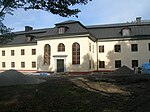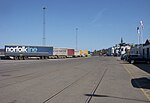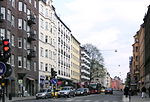Danviksbro

Danviksbron or, alternatively, Danviksbro ("Danvik Bridge") is a bascule bridge in central Stockholm, Sweden, connecting the eastern end of Södermalm to the eastern municipality Nacka. Under the bridge, the canal Hammarbykanalen carries the water of Hammarby Sjö over to Saltsjön. The bridge, actually two separate bridges, carries the railway Saltsjöbanan and a road. For unknown reasons the location of the bridge, like many other places along the shores of Sweden and Norway, was named 'Danviken', meaning danernas vik, "The Bay of the Danes", and until the early 20th century most people called it Dannviken (short a, like Danmark is still pronounced) rather than, as is common today, Daanviken (long a).
Excerpt from the Wikipedia article Danviksbro (License: CC BY-SA 3.0, Authors, Images).Danviksbro
Danviksbron, Stockholm Södermalm (Södermalms stadsdelsområde)
Geographical coordinates (GPS) Address External links Nearby Places Show on map
Geographical coordinates (GPS)
| Latitude | Longitude |
|---|---|
| N 59.313611111111 ° | E 18.104722222222 ° |
Address
Danviksbron (Danviksbro)
Danviksbron
116 44 Stockholm, Södermalm (Södermalms stadsdelsområde)
Sweden
Open on Google Maps











